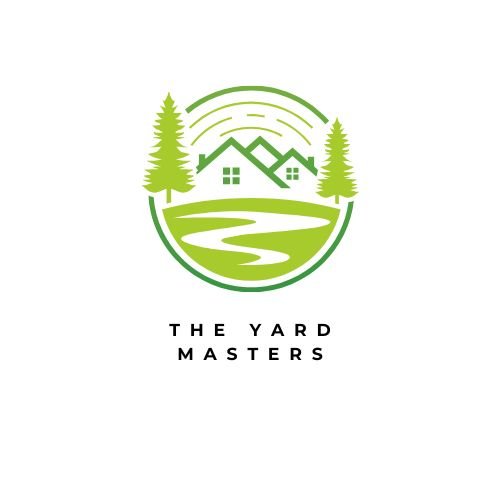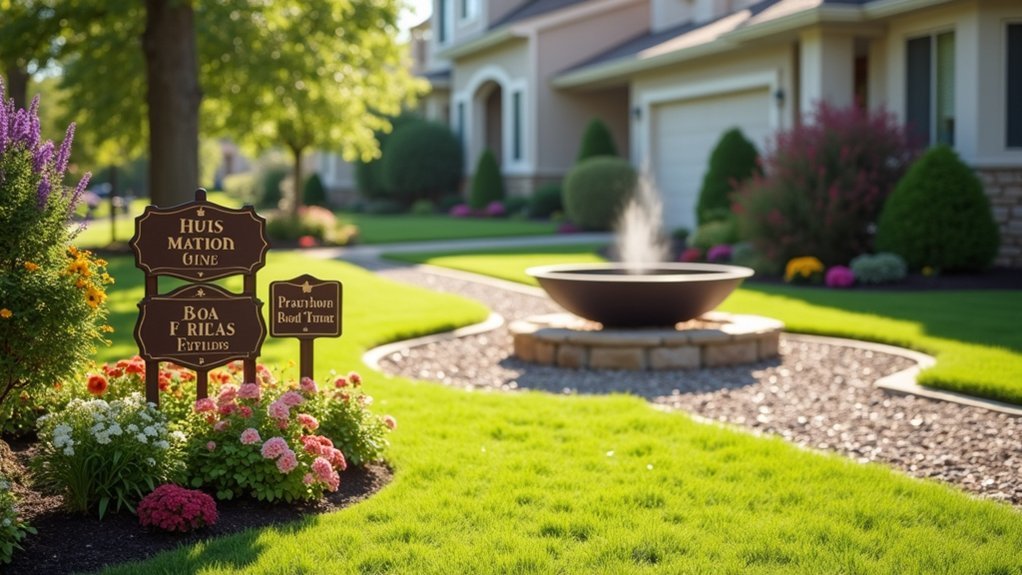You’ll need to maintain 10 feet from property lines and 25 feet from combustible materials when placing your fire pit. Your HOA likely restricts size to 3 feet diameter maximum and requires gas over wood-burning models. You must obtain written approval before installation, submit design plans, and create a non-combustible foundation. Adult supervision is mandatory during use, with operating hours typically ending by 10 PM. Don’t forget to notify your insurance provider to maintain coverage and explore additional safety requirements.
Minimum Distance Requirements From Property Lines and Structures

Three critical distance requirements determine where you can safely place your fire pit within HOA guidelines.
First, maintain at least 10 feet from property lines to comply with local regulations and prevent neighbor disputes.
Keep fire pits at least 10 feet from property boundaries to meet regulations and avoid neighbor conflicts.
Second, keep your fire pit area 25 feet away from combustible materials like wooden fences, shrubs, or structures to minimize fire risks.
Third, guarantee 21 feet of vertical clearance above the pit to prevent heat and smoke damage to overhead structures.
You’ll also need level ground for stability and safety.
Don’t place your pit on uneven surfaces that could cause tipping or dangerous heat transfer.
Always verify your specific homeowners associations requirements, as they often impose stricter minimum distance requirements than standard local codes mandate.
Approved Fire Pit Types and Size Restrictions
Your HOA’s fire pit regulations will specify which fuel types you can use, with most communities favoring gas models over wood-burning options due to safety and air quality concerns.
You’ll need to stay within strict size limits, typically no more than 3 feet in diameter and 2 feet in height, to comply with standard HOA guidelines.
Check if your community maintains a pre-approved model list, as using an approved fire pit can streamline your installation process and guarantee automatic compliance.
Gas Vs Wood Types
When choosing between gas and wood fire pits for your property, you’ll find that gas options typically face fewer HOA restrictions than their wood-burning counterparts.
Gas fire pits burn cleaner and pose reduced fire hazards, making them the preferred choice in many communities with strict fire pit regulations.
Wood-burning fire pit installations often require compliance with additional local ordinances regarding burning materials and safety practices.
You’ll need to follow specific guidelines about what materials you can burn and when you can use your pit.
Propane and natural gas models offer convenient operation with simple on-off controls, eliminating concerns about ash disposal and smoke production.
This convenience factor, combined with their safer operation profile, explains why most HOAs readily approve gas fire pits while maintaining stricter oversight on wood-burning alternatives.
Maximum Size Limits
Most HOAs establish strict dimensional requirements for fire pits, typically capping diameter at 3 feet and height at 2 feet to maintain neighborhood safety standards.
These maximum size limits aren’t arbitrary—they’re designed to align with local laws and prevent excessive flames that could endanger nearby structures or landscaping.
Understanding your HOA’s specific size restrictions helps you choose compliant equipment while implementing proper safety precautions.
Here’s what you’ll typically encounter:
- Diameter restrictions of 3 feet maximum for above-ground units
- Height limitations of 2 feet to control flame size
- Enclosed side requirements of 6-12 inches minimum for ember containment
- Base depth mandates of 10+ inches for in-ground installations
You’ll need to verify these requirements with your HOA before purchasing any fire pit equipment to guarantee compliance.
Pre-Approved Model Lists
Beyond establishing general size parameters, many HOAs streamline the approval process by maintaining pre-approved model lists that specify exactly which fire pit types and brands meet community standards.
These lists typically feature fire pits that don’t exceed 3 feet in diameter and 2 feet in height, constructed from non-combustible materials like heavy-duty metal, brick, or stone.
Pre-approved model lists eliminate guesswork by providing specific manufacturer names and model numbers that automatically meet your community’s requirements. This guarantees fire pit safety while maintaining aesthetic consistency throughout the neighborhood.
However, you’ll still need to check with local fire authorities for any municipal restrictions that might override HOA guidelines.
Always review your HOA’s governing documents first, as some communities require submission of installation plans even for pre-approved models.
Required Site Preparation and Non-Combustible Surface Standards
Before installing any fire pit, you’ll need to establish a proper non-combustible foundation that meets both safety requirements and HOA standards.
Proper site preparation involves creating a stable base using approved materials that won’t ignite or deteriorate under extreme heat.
Your non-combustible surface must include these essential components:
- Gravel, brick, or concrete pavers as the primary foundation material
- A base depth of at least ten inches using rock, sand, or gravel for stability
- Fire-resistant barriers extending beyond the pit’s perimeter
- Level ground preparation to prevent structural issues
Fire safety regulations require maintaining proper clearance around your installation.
Keep the surrounding area free of flammable materials within a 15-25 foot radius.
Regular inspections guarantee your foundation remains compliant with HOA standards and continues providing adequate protection.
Mandatory Approval Process and Documentation Requirements

Once you’ve completed your site preparation, obtaining HOA approval becomes your next priority. The mandatory approval process requires specific documentation requirements that demonstrate compliance with community standards and safety regulations.
| Document Type | Required Information |
|---|---|
| Design Plans | Dimensions, materials, aesthetics |
| Location Survey | Yard placement and setback distances |
| Safety Compliance | Local fire codes verification |
| Installation Timeline | Project start and completion dates |
You’ll need to submit detailed plans showing your fire pit’s design, dimensions, and materials. Your HOA may require fire codes review to guarantee all safety standards are met. Clear communication with your HOA board is essential, as many provide specific guidelines or forms. Remember, failure to obtain prior approval can result in violation notices or removal demands.
Burn Material Restrictions and Fuel Type Guidelines
Understanding your HOA’s burn material restrictions prevents costly violations and keeps your community safe.
These fuel type guidelines vary greatly between communities, especially in wildfire-prone areas where strict local regulations apply.
Most HOAs permit only specific materials that meet fire safety standards:
- Clean, dry, split firewood – the most commonly allowed wood-burning option
- Propane or natural gas – preferred in high-risk fire zones
- Gel fuel – often acceptable for decorative fire features
- NFPA-compliant materials – any fuel meeting National Fire Protection Association standards
You’re prohibited from burning treated wood, plastic, paper, or other toxic materials under virtually all HOA rules.
Some neighborhoods ban wood-burning entirely, requiring gas-only fire pits.
Always verify your community’s burn material restrictions with your HOA before purchasing fuel to avoid fines and violations.
Supervision and Operating Hour Limitations

You’ll need to guarantee an adult supervises your fire pit at all times, as HOAs typically mandate constant oversight for safety and liability reasons.
Most communities also enforce specific operating hours that restrict when you can light fires, often prohibiting late evening or early morning use to prevent neighbor complaints.
Check your HOA’s exact time restrictions since these rules vary considerably between communities and can result in fines if violated.
Adult Supervision Requirements
When it comes to fire pit safety, responsible adult supervision isn’t just recommended—it’s mandatory under most HOA regulations.
These safety guidelines exist to minimize fire risk and guarantee compliance with local ordinances that govern outdoor burning activities.
Your HOA likely requires constant adult oversight whenever your fire pit’s in use. This means you can’t leave children unattended around open flames, even briefly.
Many associations also prohibit fire pit operation during high winds, requiring adults to monitor weather conditions continuously.
Essential adult supervision requirements include:
- Maintaining constant presence throughout the entire burn session
- Keeping fire extinguishers or water sources within immediate reach
- Monitoring wind conditions and extinguishing fires when unsafe
- Guaranteeing compliance with HOA operating hours and noise restrictions
Violating these supervision requirements can result in HOA violation notices and potential fines.
Time Restrictions Rules
Although fire pits create wonderful ambiance for evening gatherings, your HOA’s time restrictions dictate exactly when you can operate them.
Most HOAs limit fire pit use to specific evening hours, typically ending by 10 PM to minimize noise disturbances for neighbors. You’ll need to respect designated “quiet hours” when fire pit operation is completely prohibited.
Your local fire department may impose additional time restrictions during high fire risk periods, overriding standard HOA guidelines.
These municipal ordinances often change seasonally, so you must stay informed about both HOA and local regulations.
Violating time restrictions results in HOA violation notices, potentially leading to fines or enforcement actions.
Always verify current operating hours with your HOA board and check local fire department advisories before lighting your fire pit.
Insurance Disclosure and Liability Considerations
Installing a fire pit triggers important insurance obligations that can greatly impact your financial protection. You must notify your insurance provider about the installation, especially in wildfire-prone areas, to maintain coverage and avoid claim denials.
Your liability considerations extend beyond basic insurance disclosure requirements:
- Follow local fire regulations and HOA safety guidelines to maintain policy compliance
- Report installations promptly to prevent coverage gaps for fire damage or injury claims
- Implement required safety measures like proper placement and clearance distances
- Document compliance with all regulations to support future claims if needed
Failing to meet these insurance disclosure obligations puts you at serious financial risk. You’re personally liable for any damages or injuries your fire pit causes.
Undisclosed fire pit installations create significant financial liability exposure, leaving homeowners personally responsible for all resulting damages and injuries.
However, many insurers offer discounts when you demonstrate proper compliance with safety protocols.
Frequently Asked Questions
Do and Don’ts of Fire Pit?
You should place your fire pit 10+ feet from property lines, burn only dry firewood, supervise constantly, use non-combustible materials, and check local regulations. Don’t burn trash or treated wood.
Do Most HOAS Allow Fire Pits?
Most HOAs do allow fire pits, but you’ll need to check your specific community’s governing documents. Rules vary considerably between associations, and you’ll likely face restrictions on size, fuel type, and placement requirements.
How Far From Your House Should You Put a Fire Pit?
You should place your fire pit at least 10 feet from your house, though local codes may require 25 feet from combustible materials. Always check your specific HOA and municipal regulations first.
Where Should You Not Put a Fire Pit?
Don’t place your fire pit within 10 feet of property lines, under overhanging branches, near combustible materials, on uneven ground, or in utility easements where it’ll create safety hazards.





Leave a Reply